Sonic Weapons Blamed for U.S. Diplomats' Hearing Loss in Cuba
U.S. investigators found hidden devices, but Cuba denies responsibility.

In 2016, United States diplomats in Havana began suffering unexplained hearing losses. A lengthy investigation by U.S. officials identified the probable source of the diplomats’ hearing issues: covert sonic devices near their living quarters that operated outside of audible frequencies. It’s not clear who placed the devices there or whether the devices were intended to be weapons or serve some other purpose.
The incident renewed tensions between the U.S. and Cuba just two years into the newly loosened relationship between the two countries. As retaliation for the incident, the U.S. expelled two Cuban diplomats from the embassy in Washington, D.C. in May.
Cuba denies that it had anything to do with the sonic devices, which were found in diplomatic housing owned and maintained by Cuba. Investigators are looking into the possibility that a third party, such as Russia, was behind the devices. It’s nothing new for foreign diplomats to be closely monitored, but if these devices are indeed sonic weapons, their use against diplomats would be unprecedented.
Militaries around the world have explored sonic weapons as forms of non-lethal weaponry for years, including devices for both crowd dispersal and battlefield weaponry. While the Associated Press reports that five U.S. diplomats suffered hearing loss, this knowledge comes from anonymous sources who are not permitted to comment on the ongoing investigation. Publicly, U.S. State Department spokesperson Heather Nauert has simply said that an undisclosed number of diplomats experienced “a variety of physical symptoms.”
Whether the symptoms are purely auditory or extend to other physical maladies is not clear, but these reports are consistent with the known effects of exposure to high-intensity sound.
Even if a sonic weapon operates outside the audible range, though — as investigators of the Cuban incident have suggested — it can cause hearing damage. According to Science Magazine, sounds that are so low-frequency that people can barely perceive them can still cause lasting damage to the inner ear. It’s possible that the devices in question emitted sounds that were either above or below the normal hearing range of adults. Such non-audible devices are referred to as infrasonic or ultrasonic.
Non-audible sounds, produced by infrasonic devices, can cause pain and disorientation.
While the Cuban incident affected only State Department employees and not private citizens, the most high-profile cases of weaponized sound in recent memory actually involved sonic weapons being used against civilians.
The LRAD Sound Cannon — which stands for “long-range acoustic hailing device” — is manufactured in several sizes by the LRAD Corporation. Here, you can see the New York City Police Department using it against protesters:
“Anyone within 15 meters of the device’s audio path can experience permanent hearing loss,” Gizmodo reported in August 2014, when police in Ferguson, Missouri, used LRAD devices against protestors. The outlet also noted that anyone within 100 meters of the sound’s path will experience extreme pain. And while exposure to these sonic weapons can cause hearing loss like that described by U.S. diplomats, as you can hear in the video, the LRAD devices are very audible. Whatever happened in Cuba was most likely way smaller, so as to remain hidden.
As neuroscientist Seth Horowitz described in Popular Science, it’s entirely possible to exploit sound waves to cause nausea, discomfort, and theoretically even make someone’s head explode (though he suggests that the 240 decibels required to do this last one would be so energy- and equipment-intensive that at that point you may as well just use a baseball bat).
More will be revealed on the Cuban incident, but the known science and theoretical science of sonic weaponry suggest that it’s totally possible to secretly cause hearing damage.